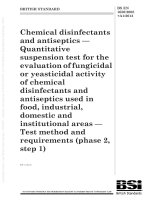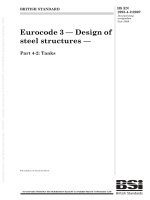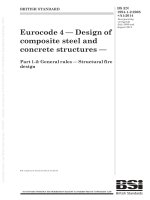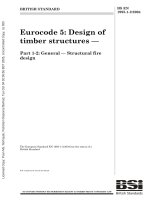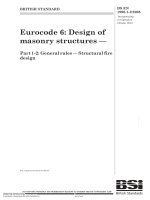Bsi bs en 61753 143 2 2013
Bạn đang xem bản rút gọn của tài liệu. Xem và tải ngay bản đầy đủ của tài liệu tại đây (1.24 MB, 26 trang )
BS EN 61753-143-2:2013
BSI Standards Publication
Fibre optic interconnecting
devices and passive
components — Performance
standard
Part 143-2: Optical passive VIPA-based
dispersion compensator of single-mode
fibre transmission for category C —
Controlled environments
NO COPYING WITHOUT BSI PERMISSION EXCEPT AS PERMITTED BY COPYRIGHT LAW
raising standards worldwide™
BRITISH STANDARD
BS EN 61753-143-2:2013
National foreword
This British Standard is the UK implementation of EN 61753-143-2:2013. It is
identical to IEC 61753-143-2:2012.
The UK participation in its preparation was entrusted by Technical Committee
GEL/86, Fibre optics, to Subcommittee GEL/86/2, Fibre optic interconnecting
devices and passive components.
A list of organizations represented on this committee can be obtained on
request to its secretary.
This publication does not purport to include all the necessary provisions of a
contract. Users are responsible for its correct application.
© The British Standards Institution 2013
Published by BSI Standards Limited 2013
ISBN 978 0 580 69514 8
ICS 33.180.20
Compliance with a British Standard cannot confer immunity from
legal obligations.
This British Standard was published under the authority of the Standards
Policy and Strategy Committee on 28 February 2013.
Amendments issued since publication
Amd. No.
Date
Text affected
BS EN 61753-143-2:2013
EN 61753-143-2
EUROPEAN STANDARD
NORME EUROPÉENNE
EUROPÄISCHE NORM
February 2013
ICS 33.180.20
English version
Fibre optic interconnecting devices and passive components Performance standard Part 143-2: Optical passive VIPA-based dispersion compensator of singlemode fibre transmission for category C Controlled environment
(IEC 61753-143-2:2012)
Dispositifs d'interconnexion et composants
passifs à fibres optiques Norme de performance Partie 143-2: Compensateur de dispersion
reposant sur le VIPA passif optique de
transmission par fibre unimodale pour la
catégorie C Environnement contrôlé
(CEI 61753-143-2:2012)
Lichtwellenleiter Verbindungselemente und passive
Bauteile - Betriebsverhalten Teil 143-2: VIPA-basierender passiver
optischer Dispersionskompensator für
Einmodenfaserübertragung für die
Kategorie C Kontrollierte Umgebung
(IEC 61753-143-2:2012)
This European Standard was approved by CENELEC on 2012-12-20. CENELEC members are bound to comply
with the CEN/CENELEC Internal Regulations which stipulate the conditions for giving this European Standard
the status of a national standard without any alteration.
Up-to-date lists and bibliographical references concerning such national standards may be obtained on
application to the CEN-CENELEC Management Centre or to any CENELEC member.
This European Standard exists in three official versions (English, French, German). A version in any other
language made by translation under the responsibility of a CENELEC member into its own language and notified
to the CEN-CENELEC Management Centre has the same status as the official versions.
CENELEC members are the national electrotechnical committees of Austria, Belgium, Bulgaria, Croatia, Cyprus,
the Czech Republic, Denmark, Estonia, Finland, Former Yugoslav Republic of Macedonia, France, Germany,
Greece, Hungary, Iceland, Ireland, Italy, Latvia, Lithuania, Luxembourg, Malta, the Netherlands, Norway, Poland,
Portugal, Romania, Slovakia, Slovenia, Spain, Sweden, Switzerland, Turkey and the United Kingdom.
CENELEC
European Committee for Electrotechnical Standardization
Comité Européen de Normalisation Electrotechnique
Europäisches Komitee für Elektrotechnische Normung
Management Centre: Avenue Marnix 17, B - 1000 Brussels
© 2013 CENELEC -
All rights of exploitation in any form and by any means reserved worldwide for CENELEC members.
Ref. No. EN 61753-143-2:2013 E
BS EN 61753-143-2:2013
EN 61753-143-2:2013
-2-
Foreword
The text of document 86B/3491/FDIS, future edition 1 of IEC 61753-143-2, prepared by SC 86B,
"Fibre optic interconnecting devices and passive components", of IEC TC 86, "Fibre optics" was
submitted to the IEC-CENELEC parallel vote and approved by CENELEC as EN 61753-143-2:2013.
The following dates are fixed:
•
•
latest date by which the document has
to be implemented at national level by
publication of an identical national
standard or by endorsement
latest date by which the national
standards conflicting with the
document have to be withdrawn
(dop)
2013-09-20
(dow)
2015-12-20
Attention is drawn to the possibility that some of the elements of this document may be the subject of
patent rights. CENELEC [and/or CEN] shall not be held responsible for identifying any or all such
patent rights.
Endorsement notice
The text of the International Standard IEC 61753-143-2:2012 was approved by CENELEC as a
European Standard without any modification.
In the official version, for Bibliography, the following note has to be added for the standard indicated:
IEC 61978-1
NOTE Harmonized as EN 61978-1.
-3-
BS EN 61753-143-2:2013
EN 61753-143-2:2013
Annex ZA
(normative)
Normative references to international publications
with their corresponding European publications
The following documents, in whole or in part, are normatively referenced in this document and are
indispensable for its application. For dated references, only the edition cited applies. For undated
references, the latest edition of the referenced document (including any amendments) applies.
NOTE When an international publication has been modified by common modifications, indicated by (mod), the relevant EN/HD
applies.
Publication
Year
Title
EN/HD
Year
IEC 60793-1
Series Optical fibres Part 1: Measurement methods and test
procedures
EN 60793-1
Series
IEC 60793-2-50
-
EN 60793-2-50
-
IEC 61300
Series Fibre optic interconnecting devices and
passive components - Basic test and
measurement procedures
EN 61300
Series
IEC 61300-2-1
-
Fibre optic interconnecting devices and
passive components - Basic test and
measurement procedures Part 2-1: Tests - Vibration (sinusoidal)
EN 61300-2-1
-
IEC 61300-2-4
-
Fibre optic interconnecting devices and
passive components - Basic test and
measurement procedures Part 2-4: Tests - Fibre/cable retention
EN 61300-2-4
-
IEC 61300-2-9
-
Fibre optic interconnecting devices and
passive components - Basic test and
measurement procedures Part 2-9: Tests - Shock
EN 61300-2-9
-
IEC 61300-2-17
-
Fibre optic interconnecting devices and
passive components - Basic test and
measurement procedures Part 2-17: Tests - Cold
EN 61300-2-17
-
IEC 61300-2-18
-
Fibre optic interconnecting devices and
EN 61300-2-18
passive components - Basic test and
measurement procedures Part 2-18: Tests - Dry heat - High temperature
endurance
-
IEC 61300-2-19
-
Fibre optic interconnecting devices and
passive components - Basic test and
measurement procedures Part 2-19: Tests - Damp heat (steady state)
EN 61300-2-19
-
IEC 61300-2-22
-
Fibre optic interconnecting devices and
passive components - Basic test and
measurement procedures Part 2-22: Tests - Change of temperature
EN 61300-2-22
-
Optical fibres Part 2-50: Product specifications - Sectional
specification for class B single-mode fibres
BS EN 61753-143-2:2013
EN 61753-143-2:2013
-4-
IEC 61300-2-42
-
Fibre optic interconnecting devices and
passive components - Basic test and
measurement procedures Part 2-42: Tests - Static side load for
connectors
EN 61300-2-42
-
IEC 61300-2-44
-
Fibre optic interconnecting devices and
EN 61300-2-44
passive components - Basic test and
measurement procedures Part 2-44: Tests - Flexing of the strain relief of
fibre optic devices
-
IEC 61300-3-2
-
Fibre optic interconnecting devices and
EN 61300-3-2
passive components - Basic test and
measurement procedures Part 3-2: Examinations and measurements Polarization dependent loss in a single-mode
fibre optic device
-
IEC 61300-3-4
-
Fibre optic interconnecting devices and
passive components - Basic test and
measurement procedures Part 3-4: Examinations and measurements Attenuation
EN 61300-3-4
-
IEC 61300-3-7
-
Fibre optic interconnecting devices and
passive components - Basic test and
measurement procedures Part 3-7: Examinations and measurements Wavelength dependence of attenuation and
return loss of single mode components
EN 61300-3-7
-
IEC 61300-3-32
-
Fibre optic interconnecting devices and
EN 61300-3-32
passive components - Basic test and
measurement procedures Part 3-32: Examinations and measurements Polarisation mode dispersion measurement
for passive optical components
-
IEC 61300-3-38
-
Fibre optic interconnecting devices and
EN 61300-3-38
passive components - Basic test and
measurement procedures Part 3-38:Examinations and measurements Group delay, chromatic dispersion and phase
ripple
-
IEC 61753-1
-
Fibre optic interconnecting devices and
EN 61753-1
passive components performance standard Part 1: General and guidance for performance
standards
-
IEC 62074-1
-
Fibre optic interconnecting devices and
passive components - Fibre optic WDM
devices Part 1: Generic specification
-
EN 62074-1
–2–
BS EN 61753-143-2:2013
61753-143-2 IEC:2012
CONTENTS
INTRODUCTION ..................................................................................................................... 5
1
Scope ............................................................................................................................... 6
2
Normative references ....................................................................................................... 6
3
Terms, definitions and abbreviations ................................................................................ 7
4
Test .................................................................................................................................. 8
5
Test report ........................................................................................................................ 8
6
Performance requirements ............................................................................................... 8
6.1
6.2
6.3
6.4
Annex A
Reference components ............................................................................................ 8
Dimensions ............................................................................................................. 9
Sample size ............................................................................................................ 9
Test details and requirements ................................................................................. 9
(normative) Sample size ....................................................................................... 17
Annex B (informative) Virtually imaged phased array (VIPA) Technology .............................. 18
Bibliography .......................................................................................................................... 20
Figure B.1 – Structure of virtually imaged phased array (VIPA) ............................................. 18
Figure B.2 – Detailed light path and mechanism of generating chromatic dispersion ............. 19
Table 1 – Test and requirements for C-band and L-band WDM application ........................... 10
Table 2 – Test and requirements for C-band WDM application ............................................. 11
Table 3 – Test and requirements for L-band WDM application .............................................. 12
Table 4 – Common test and requirements ............................................................................. 13
Table A.1 – Sample size ....................................................................................................... 17
BS EN 61753-143-2:2013
61753-143-2 IEC:2012
–5–
INTRODUCTION
The International Electrotechnical Commission (IEC) draws attention to the fact that it is claimed
that compliance with this document may involve the use of a patent concerning the optical
dispersion compensator given in Clauses 1 to 6. IEC takes no position concerning the evidence,
validity and scope of this patent right.
The holder of this patent right has assured the IEC that he/she is willing to negotiate licences
either free of charge or under reasonable and non-discriminatory terms and conditions with
applicants throughout the world. In this respect, the statement of the holder of this patent right is
registered with IEC. Information may be obtained from:
Fujitsu Limited
Standards Center, Intellectual property unit
1-1, Kamikodanaka 4-chome, Nakahara-ku, Kawasaki-shi, Kanagawa
211-8588 Japan
Attention is drawn to the possibility that some of the elements of this document may be the
subject of patent rights other than those identified above. IEC shall not be held responsible for
identifying any or all such patent rights.
IEC () maintains on-line databases of patents relevant to their standards.
Users are encouraged to consult the databases for the most up to date information concerning
patents.
–6–
BS EN 61753-143-2:2013
61753-143-2 IEC:2012
FIBRE OPTIC INTERCONNECTING
DEVICES AND PASSIVE COMPONENTS –
PERFORMANCE STANDARD –
Part 143-2: Optical passive VIPA-based dispersion
compensator of single-mode fibre transmission for category C –
Controlled environment
1
Scope
This part of IEC 61753 contains the minimum test and measurement requirements and severity
levels that a passive chromatic dispersion compensator (PCDC) using virtually imaged phased
array (VIPA) must satisfy in order to be categorized as meeting the IEC standard, category
C-controlled environments.
Generally, PCDCs are used to reduce the magnitude of chromatic dispersion (CD) between
regenerators by adding CD to the span that has a sign opposite to the total CD of the fibre cable
and components. The requirements cover non-connectorized PCDCs used in single-channel
transmission and wavelength division multiplexing (WDM) transmission in single-mode fibres
(IEC 60793-2-50 B1/B2/B4).
2
Normative references
The following documents, in whole or in part, are normatively referenced in this document and
are indispensable for its application. For dated references, only the edition cited applies. For
undated references, the latest edition of the referenced document (including any amendments)
applies.
IEC 60793-1 (all parts), Optical fibres – Measurement methods and test procedures
IEC 60793-2-50, Optical fibres – Part 2-50: Product specifications – Sectional specification for
class B single-mode fibres
IEC 61300 (all parts), Fibre optic interconnecting devices and passive components – Basic test
and measurement procedures
IEC 61300-2-1, Fibre optic interconnecting devices and passive components – Basic test and
measurement procedures – Part 2-1: Tests – Vibration (sinusoidal)
IEC 61300-2-4, Fibre optic interconnecting devices and passive components – Basic test and
measurement procedures – Part 2-4: Tests – Fibre/cable retention
IEC 61300-2-9, Fibre optic interconnecting devices and passive components – Basic test and
measurement procedures – Part 2-9: Tests – Shock
IEC 61300-2-17, Fibre optic interconnecting devices and passive components – Basic test and
measurement procedures – Part 2-17: Tests – Cold
IEC 61300-2-18, Fibre optic interconnecting devices and passive components – Basic test and
measurement procedures – Part 2-18: Tests – Dry heat – High temperature endurance
BS EN 61753-143-2:2013
61753-143-2 IEC:2012
–7–
IEC 61300-2-19, Fibre optic interconnecting devices and passive components – Basic test and
measurement procedures – Part 2-19: Tests – Damp heat (steady state)
IEC 61300-2-22, Fibre optic interconnecting devices and passive components – Basic test and
measurement procedures – Part 2-22: Tests – Change of temperature
IEC 61300-2-42, Fibre optic interconnecting devices and passive components – Basic test and
measurement procedures – Part 2-42: Tests – Static side load for connectors
IEC 61300-2-44, Fibre optic interconnecting devices and passive components – Basic test and
measurement procedures – Part 2-44: Tests – Flexing of the strain relief of fibre optic devices
IEC 61300-3-2, Fibre optic interconnecting devices and passive components – Basic test and
measurement procedures – Part 3-2: Examination and measurements – Polarization dependent
loss in a single-mode fibre optic device
IEC 61300-3-4, Fibre optic interconnecting devices and passive components – Basic test and
measurement procedures – Part 3-4: Examinations and measurements – Attenuation
IEC 61300-3-7, Fibre optic interconnecting devices and passive components – Basic test and
measurement procedures – Part 3-7: Examinations and measurements – Wavelength
dependence of attenuation and return loss of single mode components
IEC 61300-3-32, Fibre optic interconnecting devices and passive components – Basic test and
measurement procedures – Part 3-32: Examinations and measurements – Polarization mode
dispersion measurement for passive optical components
IEC 61300-3-38, Fibre optic interconnecting devices and passive components – Basic test and
measurement procedures – Part 3-38: Examinations and measurements – Group delay,
chromatic dispersion and phase ripple
IEC 61753-1, Fibre optic interconnecting devices and passive components performance
standard – Part 1: General and guidance for performance standards
IEC 62074-1, Fibre optic interconnecting devices and passive components – Fibre optic WDM
devices – Part 1: Generic specification
3
Terms, definitions and abbreviations
For the purposes of this document, the following terms, definitions and abbreviations apply.
3.1
Terms and definitions
3.1.1
chromatic dispersion
CD
derivative of group delay with respect to wavelength or frequency
Note 1 to entry: A typical unit is ps/nm or ps/GHz. The chromatic dispersion generally varies with the operating
wavelength.
3.1.2
polarization dependent loss
PDL
maximum variation of insertion loss due to a variation of the state of polarization (SOP) over all
the SOPs
–8–
BS EN 61753-143-2:2013
61753-143-2 IEC:2012
3.1.3
wavelength dependent loss
WDL
maximum variation of the insertion loss over operating wavelength range
3.1.4
polarization mode dispersion
PMD
when an optical signal passes through an optical fibre, component or subsystem, the change in
the shape and width of the pulse due to the average delay of the travelling time between the two
principal states of polarization (PSP), differential group delay (DGD), and/or to the waveform
distortion for each PSP, is called PMD
Note 1 to entry: PMD, together with polarization dependent loss (PDL) and polarization dependent gain (PDG), when
applicable, may introduce waveform distortion leading to unacceptable bit error rate increase.
3.2
Abbreviations
CD
Chromatic dispersion
DGD
Differential group delay
FWHM Full width at half maximum
PCDC
Passive chromatic dispersion compensator
PDL
Polarization dependent loss
PMD
Polarization mode dispersion
PSP
Principal states of polarization
SMF
Single mode fibres
SOP
State of polarization
VIPA
Virtually imaged phased array
WDL
Wavelength dependent loss
WDM
Wavelength division multiplexing
4
Test
All test methods are in accordance with IEC 61300.
The samples shall be terminated onto single mode fibres specified according to the relevant
IEC classification for single mode fibres (SMF) (IEC 60793-1 series).
All tests shall be carried out to validate performance over the required optical pass bands, as
defined in IEC 62074-1. Single or multiple pass bands corresponding to the PCDC specifications
can be chosen for the qualification and differing target specifications may be assigned to each
pass band.
5
Test report
Fully documented test reports and supporting evidence shall be prepared and be available for
inspections as evidence that the tests have been carried out and complied with.
6
6.1
Performance requirements
Reference components
The testing for these components does not require the use of reference components.
BS EN 61753-143-2:2013
61753-143-2 IEC:2012
6.2
–9–
Dimensions
Dimensions shall comply with either an appropriate IEC interface standard or with those given in
appropriate manufacturing drawings, where the IEC interface standard does not exist or cannot
be used.
6.3
Sample size
Sample sizes for the tests are defined in Annex A.
6.4
Test details and requirements
The requirements are given only for dispersion compensator. For connectorized components,
the connector performances shall be in compliance with IEC 61753-1. Tables 1 to 4 give test
details and requirements for these devices.
– 10 –
BS EN 61753-143-2:2013
61753-143-2 IEC:2012
Table 1 – Test and requirements for C-band and L-band WDM application
No
Tests
1
Chromatic
dispersion deviation
Requirements
Chromatic dispersion is specified for the
operational wavelength range.
IEC 61300-3-38
Details
The deviation of chromatic
dispersion shall be determined as
the worst case over the operational
wavelength range.
100 GHz spacing type
|CD| < 500 ps/nm (FWHM; 50 GHz)
|CD| < 1 200 ps/nm(FWHM; 40 GHz)
200 GHz spacing type
|CD| < 400 ps/nm (FWHM; 60 GHz)
The deviation of chromatic dispersion:
≤ 5 % of the nominal chromatic dispersion value
2
Insertion loss
≤ 9,5 dB
IEC 61300-3-4
(not including the optical circulator)
IEC 61300-3-7
3
PDL
The insertion loss shall be
determined as the worst case over
the operational wavelength range.
≤ 0,6 dB
The PDL shall be determined as the
worst case over all polarization
states for the operation wavelength
range.
≤ 1,5 dB
Fibre lengths of PCDC pigtail:
≥ 1,5 m
PMD
≤ 0,8 ps |CD| < 500 ps/nm
IEC 61300-3-32
≤ 1,5 ps |CD| < 1 800 ps/nm
The PMD shall be determined as the
worst case over all polarization
states for the operation wavelength
range.
IEC 61300-3-2
Method 1
4
Fibre lengths of PCDC pigtail:
≥ 1,5 m.
WDL
IEC 61300-3-4
IEC 61300-3-7
5
CD is the nominal chromatic dispersion with a
unit of ps/nm.
NOTE
Operating wavelength range: C-band 1 530 nm to 1 565 nm, L-band 1 565 nm to 1 625 nm.
BS EN 61753-143-2:2013
61753-143-2 IEC:2012
– 11 –
Table 2 – Test and requirements for C-band WDM application
No
Tests
1
Chromatic
dispersion deviation
Requirements
Chromatic dispersion is specified for the
operational wavelength range.
IEC 61300-3-38
Details
The deviation of chromatic
dispersion shall be determined as
the worst case over the operational
wavelength range.
100 GHz spacing type
|CD| < 500 ps/nm (FWHM; 50 GHz)
|CD| < 1 200 ps/nm(FWHM; 40 GHz)
200 GHz spacing type
|CD| < 400 ps/nm (FWHM; 60 GHz)
The deviation of chromatic dispersion:
≤ 5 % of the nominal chromatic dispersion value
2
Insertion loss
≤ 9,5 dB
IEC 61300-3-4
(not including the optical circulator)
IEC 61300-3-7
3
PDL
The insertion loss shall be
determined as the worst case over
the operational wavelength range.
≤ 0,6 dB
The PDL shall be determined as the
worst case over all polarization
states for the operation wavelength
range.
≤ 0,85 dB
Fibre lengths of PCDC pigtail:
≥ 1,5 m
PMD
≤ 0,8ps |CD| < 500 ps/nm
IEC 61300-3-32
≤ 1,5ps |CD| < 1 800 ps/nm
The PMD shall be determined as the
worst case over all polarization
states for the operation wavelength
range.
IEC 61300-3-2
Method 1
4
Fibre lengths of PCDC pigtail:
≥ 1,5 m.
WDL
IEC 61300-3-4
IEC 61300-3-7
5
CD is the nominal chromatic dispersion with a
unit of ps/nm.
NOTE
Operating wavelength range: C-band 1 530 nm to 1 565 nm.
– 12 –
BS EN 61753-143-2:2013
61753-143-2 IEC:2012
Table 3 – Test and requirements for L-band WDM application
No
Tests
1
Chromatic
dispersion deviation
Requirements
Chromatic dispersion is specified for the
operational wavelength range.
IEC 61300-3-38
Details
The deviation of chromatic
dispersion shall be determined as
the worst case over the operational
wavelength range.
100 GHz spacing type
|CD| < 500 ps/nm (FWHM; 50 GHz)
|CD| < 1 200 ps/nm(FWHM; 40 GHz)
200 GHz spacing type
|CD| < 400 ps/nm (FWHM; 60 GHz)
The deviation of chromatic dispersion:
≤ 5 % of the nominal chromatic dispersion value
2
Insertion loss
≤ 9,5 dB
IEC 61300-3-4
(not including the optical circulator)
IEC 61300-3-7
3
PDL
The insertion loss shall be
determined as the worst case over
the operational wavelength range.
≤ 0,6 dB
The PDL shall be determined as the
worst case over all polarization
states for the operation wavelength
range.
≤ 0,85 dB
Fibre lengths of PCDC pigtail:
≥ 1,5 m
PMD
≤ 0,8ps |CD| < 500ps/nm
IEC 61300-3-32
≤ 1,5ps |CD| < 1 800ps/nm
The PMD shall be determined as the
worst case over all polarization
states for the operation wavelength
range.
IEC 61300-3-2
Method 1
4
Fibre lengths of PCDC pigtail:
≥ 1,5 m.
WDL
IEC 61300-3-4
IEC 61300-3-7
5
CD is the nominal chromatic dispersion with a
unit of ps/nm.
NOTE
Operating wavelength range: L-band 1 565 nm to 1 625 nm.
BS EN 61753-143-2:2013
61753-143-2 IEC:2012
– 13 –
Table 4 – Common test and requirements (1 of 4)
No
1
Tests
Damp heat
(steady state)
IEC 61300-2-19
Requirements
Details
During the test the limits of test No. 1 and 2 in Temperature: 40 ± 2 °C.
Table 1, Table 2 or Table 3 shall be met.
+
Moreover on completion of the test the
Relative humidity: 93 32 % .
−
insertion loss of the devices shall be within
± 0,5 dB of the original value at ambient
Duration of exposure: 96 h.
conditions.
Specimens shall be optically
functioning:
Insertion loss shall be measured
before, during (at a maximum interval of
1 h) and after the test. Chromatic
dispersion shall be measured before
and after the test.
Preconditioning procedure:
Before the test, specimens shall be
maintained at room temperature
conditions for 2 h.
Recovery procedure:
After the test, specimens shall be
maintained at room temperature
conditions for 2 h.
2
Change of
temperature
IEC 61300-2-22
During the test, the limits of test No. 1 and 2 in High temperature: 60 ± 2 °C.
Table 1, Table 2 or Table 3 shall be met.
Low temperature: – 10 ± 2 °C.
Moreover on completion of the test the
insertion loss of the devices shall be within
Duration at extreme temperature:
± 0,5 dB of the original value at ambient
60 min.
conditions.
Temperature rate of change: ≥ 1 °C/min
Number of cycles: 5.
Specimens shall be optically
functioning:
Insertion loss shall be measured
before, during (at a maximum interval of
10 min) and after the test. Chromatic
dispersion shall be measured before
and after the test.
Preconditioning procedure:
Before test, specimens shall be
maintained at room temperature
conditions for 2 h.
Recovery procedure:
After test, specimens shall be
maintained at room temperature
conditions for 2 h.
– 14 –
BS EN 61753-143-2:2013
61753-143-2 IEC:2012
Table 4 (2 of 4)
No
3
Tests
High temperature
endurance
IEC 61300-2-18
Requirements
During the test the limits of test No. 1 and 2 in
Table 1, Table 2 or Table 3 shall be met.
Moreover, on completion of the test the
insertion loss of the devices shall be within
± 0,5 dB of the original value at ambient
conditions.
Details
High temperature: 60 ± 2 °C
Duration of exposure: 96 h
Specimens shall be optically
functioning:
Insertion loss shall be measured before,
during (at a maximum interval of
10 min) and after the test. Chromatic
dispersion shall be measured before
and after the test.
Preconditioning procedure:
Before test, specimens shall be
maintained at room temperature
conditions for 2 h.
Recovery procedure:
after test, specimens shall be
maintained at room temperature
conditions for 2 h.
4
Cold
IEC 61300-2-17
During the test the limits of test No. 1 and 2 in
Table 1, Table 2 or Table 3 shall be met.
Moreover on completion of the test the
insertion loss of the devices shall be within
± 0,5 dB of the original value at ambient
conditions.
Temperature: -10 ± 2 °C
Duration of exposure: 96 h
Specimens shall be optically
functioning:
Insertion loss shall be measured before,
during (at a maximum interval of
10 min) and after the test. Chromatic
dispersion shall be measured before
and after the test.
Preconditioning procedure:
Before test, specimens shall be
maintained at room temperature
conditions for 2 h.
Recovery procedure:
After test, specimens shall be
maintained at room temperature
conditions for 2 h.
BS EN 61753-143-2:2013
61753-143-2 IEC:2012
– 15 –
Table 4 (3 of 4)
No
5
Tests
Vibration
(sinusoidal)
IEC 61300-2-1
Requirements
Details
The limits of test No. 1 and 2 in Table 1, Table 2 Frequency range: 10 to 55 Hz.
or Table 3 shall be met before and after the test.
Duration per axis: 20 min.
On completion of the test the insertion loss of
the devices shall be within ± 0,5 dB of the
Number of axis: 3 orthogonal.
original value.
Number of sweeps (10-55-10 Hz):
12 per axis
Vibration amplitude: 1,52 mm
(or max. of 20 G).
Specimens shall not be actively
monitored during the test:
Insertion loss and chromatic dispersion
shall be measured before and after the
test.
6
Shock
IEC 61300-2-9
The limits of test No. 1 and 2 in Table 1, Table 2
or Table 3 shall be met before and after the test.
On completion of the test the insertion loss of
the devices shall be within ± 0,5 dB of the
original value.
50 g, 3 axes, 2 directions, 2 shocks per
direction.
12 shocks total.
Nominal 1 ms duration, half sine pulse.
Specimens shall not be actively
monitored during the test.
Insertion loss and chromatic dispersion
shall be measured before and after the
test.
7
Fibre/cable
retention
(see Note 1)
IEC 61300-2-4
The limits of test No. 1 and 2 in Table 1, Table 2 Magnitude and rate of application of the
or Table 3 shall be met. The insertion loss of the tensile load:
devices shall be within ± 0,5 dB of the original
10 N ± 1 N at a speed of 0,5 N/s for
value.
reinforced cable.
5 N ± 0,5 N at a speed of 0,5 N/s for
buffered fibres.
Point of application of tensile load:
0,3 m from the end of the device.
Duration of the test (maintaining the
load):
120 s at 10 N and 60 s at 5 N.
Sampling rate:
Insertion loss shall be measured at least
once after the load has reached its
maximum level and been maintained for
a minimum period of 30 s.
Insertion loss shall be measured before,
during and after the test, while chromatic
dispersion shall be measured before and
after the test.
– 16 –
BS EN 61753-143-2:2013
61753-143-2 IEC:2012
Table 4 (4 of 4)
No
8
Tests
Static side load
(see Notes 1 and
2)
IEC 61300-2-42
Requirements
Details
The limits of test No. 1 and 2 in Table 1, Table Magnitude and duration of the tensile
2 or Table 3 shall be met. The insertion loss of load:
the devices shall be within ± 0,5 dB of the
5 N for 5 s min. for reinforced cable.
original value.
2,3 N for 5 s min. for buffered fibres.
Point of application of tensile load:
0,3 m from the end of the device and two
mutually perpendicular directions as
permitted by the product design.
Specimens shall not be actively
monitored during the test:
Insertion loss and chromatic dispersion
shall be measured before and after the
test.
9
Optical fibre cable
flexing
IEC 61300-2-44
The limits of test No. 1 and 2 in Table 1, Table Magnitude of the tensile load:
2 or Table 3 shall be met. The insertion loss of
2 N for reinforced cable.
the devices shall be within ± 0,5 dB of the
original value.
Cycle: ± 90 °.
Number of cycles: 30.
Specimens shall not be actively
monitored during the test:
Insertion loss and chromatic dispersion
shall be measured before and after the
test.
NOTE 1
design.
These tests should be applicable to PCDCs which incorporate fibre or fibre cable pigtails in their product
NOTE 2 Static side load should be applied in two mutually perpendicular directions as permitted by the product
design. For example, a product with a base plate extending beyond the fibre exit may prohibit loading in that
direction.
BS EN 61753-143-2:2013
61753-143-2 IEC:2012
– 17 –
Annex A
(normative)
Sample size
Table A.1 gives sample sizes.
Table A.1 – Sample sizes
Item
Test
Sample
size
Source
1
Chromatic dispersion deviation
12
New
2
Insertion loss
12
Test 1
3
PDL
12
Test 2
4
WDL
12
Test 3
5
PMD
12
Test 4
6
Damp heat (steady state)
6
Test 5
7
Change of temperature
6
Test 5
8
High temperature endurance
6
Test 5
9
Cold
6
Test 5
10
Vibration(sinusoidal)
6
Test 5
11
Shock
6
Test 5
12
Fibre/cable retention
6
Test 5
13
Static side load
6
Test 5
14
Optical fibre cable flexing
6
Test 5
BS EN 61753-143-2:2013
61753-143-2 IEC:2012
– 18 –
Annex B
(informative)
Virtually imaged phased array (VIPA) technology
Figure B.1 shows the structure of virtually imaged phased array (VIPA). The input light from a
single-mode fibre is line-focused into a glass plate. The glass plate is coated on both sides and
collimated light is emitted from the reverse side of the glass after multiple reflections in the glass
plate. The light from the glass plate is focused onto a curved mirror. The reflected light travels
back to the glass plate and is finally coupled to the fibre.
Glass plate
Collimating
lens
Shorter λ
Dc> 0
3-dimensional mirror
X-axis
Optical
circulator
Line-focusing
lens
Focusing
lens
Longer λ
Dc< 0
IEC 2224/09
Figure B.1 – Structure of virtually imaged phased array (VIPA)
Figure B.2 shows the detailed light path. Each time the light is reflected at the right surface of the
glass plate, several per cent of the power passes through the reflection coating. This creates
multiple beams which seem to diverge from the corresponding beam waist in the virtual image.
The interference of these diverging beams generates collimated light. This collimated light
travels at an angle which varies with the wavelength.
Chromatic dispersion, i.e. the wavelength dependence of travelling distance, is decided by the
wavelength dependence of the pointing angle of collimated light from the glass plate and the
surface profile of the reflection mirror. The convex mirror produces negative chromatic
dispersion and the concave mirror produces positive chromatic dispersion.
Figure B.1 shows that the collimated light (grey line area on the surface of the 3-D mirror)
reflects along the concave mirror surface, which produces positive chromatic dispersion. By
shifting the position of the 3-D mirror along the X-axis, the collimated light can also reflect along
the convex mirror surface, which produces negative chromatic dispersion. If the surface profile
of the 3-D mirror is designed such that the curvature of the mirror surface is gradually changed
along the X-axis, the chromatic dispersion can be easily changed by shifting of the 3-D mirror
position along the X-axis.
BS EN 61753-143-2:2013
61753-143-2 © IEC:2012
– 19 –
ff
aa
Focusing lenslens
Focusing
Shorter wavelength
GlassPlate
plate
Glass
Shorter wavelength
3-dimensional
mirror
3-dimensional
Mirror
y
y
RR=100%
= 100 %
Centre
beamwaist
waist
Center
beam
hh=dC(y)/dy
= dC(y)/dy
Incident
Incident
angleangle
i i
c(y)
c(y)
Input
light
Input
light
Line-focusing
lens
Line-focusing
Longer
wavelength
Longer
wavelength
lens
AR
%)
AR(R~0
(R~0%)
R~98 %
R~98%
Middle
wavelength
Middle
wavelength
IEC 2115/12
Figure B.2 – Detailed light path and mechanism of generating chromatic dispersion
– 20 –
BS EN 61753-143-2:2013
61753-143-2 IEC:2012
Bibliography
IEC 61978-1, Fibre optic interconnecting devices and passive components – Fibre optic passive
chromatic dispersion compensators – Part 1: Generic specification
ITU-T Supplement N.39, Optical system design and engineering considerations (10/2003)
ITU-T Recommendation G.671, Transmission characteristics of optical components and
subsystems
_____________
This page deliberately left blank
This page deliberately left blank
